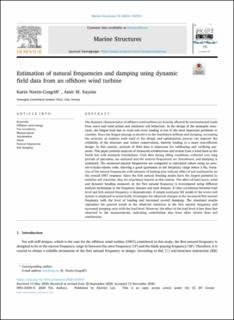| dc.description.abstract | The dynamic characteristics of offshore wind turbines are heavily affected by environmental loads from wave and wind action and nonlinear soil behaviour. In the design of the monopile structures, the fatigue load due to wind and wave loading is one of the most important problems to consider. Since the fatigue damage is sensitive to the foundation stiffness and damping, increasing the accuracy of analysis tools used in the design and optimization process can improve the reliability of the structure and reduce conservatism, thereby leading to a more cost-efficient design. In this context, analysis of field data is important for calibrating and verifying purposes. This paper presents analysis of measured accelerations and strains from a wind farm in the North Sea with monopile foundations. Field data during idling conditions, collected over long periods of operation, are analysed and the natural frequencies are determined, and damping is estimated. The measured natural frequencies are compared to calculated values using an aero- servo-hydro-elastic code, showing a good agreement in the frequency range below 2 Hz. Variation of the natural frequencies with intensity of loading may indicate effect of soil nonlinearity on the overall OWT response. Since the first natural bending modes have the largest potential to mobilize soil reactions, they are of primary interest in this context. The effect of load (wave, wind and dynamic bending moment) on the first natural frequency is investigated using different analysis techniques in the frequency domain and time domain. A clear correlation between load level and first natural frequency is demonstrated. A simple nonlinear SSI model of the tower/soil system is employed to numerically investigate the observed changes in the measured first natural frequency with the level of loading and increased overall damping. The simulated results reproduce the general trends in the observed reduction in the first natural frequency and increased damping ratio with the load level. However, the effect of the load level is less than that observed in the measurements, indicating contribution also from other factors than soil nonlinearity. | |
